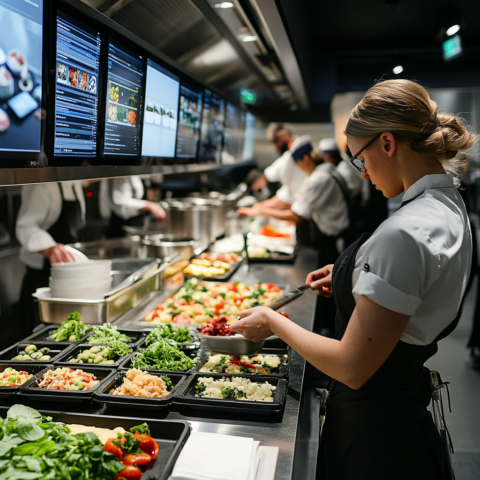The Growing Challenge of Food Waste at Events
In the realm of large-scale events, from sprawling music festivals to packed sports stadiums, food waste has emerged as a critical environmental and economic concern. The scale of this issue is staggering: in Australia alone, the hospitality sector generates 1.2 million tonnes of food waste annually, contributing significantly to greenhouse gas emissions and economic losses. Events, with their unpredictable attendance and tendency for over-preparation, are particularly prone to generating excess food waste.
However, this challenge also presents an opportunity. By implementing innovative strategies and leveraging cutting-edge technologies, event organizers and venues can significantly reduce food waste, paving the way for more sustainable events that not only minimize environmental impact but also enhance the overall customer experience.
This article explores the multifaceted approach to reducing food waste at events, examining best practices, technological innovations, and the crucial role of understanding customer behavior in creating more sustainable event experiences.
The Environmental and Economic Impact of Food Waste
The global scale of food waste is difficult to comprehend. If food waste were a country, it would rank as the third-largest emitter of greenhouse gases, surpassed only by the United States and China. This waste not only contributes to environmental degradation but also exacerbates global hunger and depletes valuable natural resources.
In the context of events, the problem is particularly acute. Approximately 20% of food served at events goes uneaten, representing a significant environmental and financial burden. In Australia, food waste costs the economy a staggering $36 billion annually, while squandering enough food to feed 7.6 million people.
For event organizers, this waste translates into increased costs across multiple fronts:
- Procurement: Purchasing excess food that goes unused
- Labor: Additional staff hours required to prepare and manage surplus food
- Disposal: Fees associated with waste removal and landfill use
Moreover, the environmental cost extends beyond the event itself, encompassing the resources used in food production, transportation, and disposal. Reducing food waste, therefore, is not just an environmental imperative but a business necessity, offering the potential for significant cost savings and improved operational efficiency.
 Innovative Solutions for Reducing Food Waste
Innovative Solutions for Reducing Food Waste
1. Data-Driven Demand Forecasting
One of the most promising innovations in waste reduction is the application of artificial intelligence (AI) to demand forecasting. These sophisticated tools analyze a wealth of data points to predict food requirements with unprecedented accuracy. Factors considered include:
- Historical data from previous events
- Current ticket sales
- Weather forecasts
- Event type and duration
- Demographic information of attendees
By integrating these AI-driven forecasting tools, venues have reported reductions in overproduction by up to 20%. For instance, a concert might require fewer meals compared to a sporting event where attendees are more likely to purchase food during breaks.
Large venues, such as those managed by Venues NSW, have taken this a step further by implementing real-time inventory monitoring systems. These systems allow kitchens to make dynamic adjustments to food production throughout the event, further minimizing waste.
2. Customizable Portions and Personalized Menus
Offering flexible portion sizes is another effective strategy in reducing plate waste. Many venues now provide options for customers to select their preferred portion size or create customized meals. This approach addresses a significant issue highlighted in the Catering Food Waste Action Plan: nearly 48% of diners leave food on their plates due to excessively large portions.
By offering smaller base portions with the option to add sides or additional servings, venues can significantly reduce waste while ensuring customer satisfaction. Some events implementing this strategy have reported a 50% reduction in plate waste.
This customization extends to menu design as well. By offering a diverse range of options catering to various dietary preferences and restrictions, venues can ensure that more of the food prepared aligns with what customers actually want to eat.
3. Sustainable and Local Sourcing
Sourcing ingredients locally and emphasizing plant-based options is another key aspect of reducing food waste. Plant-forward meals not only align with growing dietary trends but also have a significantly lower environmental impact compared to meat-based options, which require more resources to produce.
Local sourcing offers multiple benefits:
- Reduced transportation distances, lowering carbon emissions
- Fresher ingredients, less likely to spoil quickly
- Support for local economies and agriculture
- Potential for unique, seasonally-inspired menus
Venues adopting these practices have reported waste reductions of 15% to 30%, depending on the event size and food volume. For example, Accor Stadium in Sydney has partnered with local farms to source fresh produce for major events, reinforcing their commitment to sustainability while offering high-quality, locally-inspired cuisine.
Understanding the Customer: The Foundation of Waste Reduction
 While technological solutions play a crucial role, understanding customer behavior and preferences forms the foundation of effective waste reduction strategies. By aligning food offerings with customer expectations and consumption patterns, event organizers can significantly reduce both serving and plate waste.
While technological solutions play a crucial role, understanding customer behavior and preferences forms the foundation of effective waste reduction strategies. By aligning food offerings with customer expectations and consumption patterns, event organizers can significantly reduce both serving and plate waste.
1. The Power of Forecasting and Communication
Effective forecasting systems are essential in aligning meal preparation with actual demand. Traditionally, catering contracts often required over-preparation to meet contractual obligations. However, by integrating accurate forecasting data into contract negotiations, caterers can avoid significant overproduction.
Key strategies include:
- Allowing for menu item substitutions based on real-time feedback
- Adjusting quantities dynamically throughout the event
- Incorporating flexibility clauses in catering contracts
These approaches can lead to savings of up to 30% in food waste.
2. Tailoring to Customer Profiles
Different events attract different audiences, each with unique food preferences and consumption patterns. By tailoring food offerings to the specific profiles of attendees, organizers can significantly reduce waste. For example:
- Sporting events might require heartier, quick-service options
- Corporate conferences may lean towards lighter, health-conscious fare
- Music festivals might benefit from a diverse range of grab-and-go options
Utilizing historical data and maintaining open communication between clients and caterers is crucial in developing menus that align closely with attendee preferences.
3. Rethinking Service Styles: Buffets vs. Plated Meals
The choice between buffet-style service and plated meals can significantly impact food waste levels. Studies indicate that buffets generate up to 50% more waste than plated meals, primarily due to the need to maintain an appearance of abundance throughout the service period.
Strategies to mitigate waste in buffet settings include:
- Transitioning to smaller serving platters towards the end of service
- Implementing “cooked to order” stations for certain dishes
- Using smaller serving utensils to encourage modest portion sizes
For events where buffets are preferred, these tactics can help reduce waste while still offering variety and abundance to guests.
Technological Innovations Driving Sustainability
1. Real-Time Food Tracking and Monitoring
Advanced food monitoring systems represent a significant leap forward in waste reduction efforts. These systems track food consumption in real-time, allowing kitchens to make instant adjustments to production levels. Benefits include:
- Reduced overproduction by preparing food in smaller batches as needed
- Improved service efficiency by identifying popular items quickly
- Data collection for future event planning and menu optimization
A notable example is the system implemented at the US Open, which helped reduce food waste by 20% while simultaneously improving service efficiency.
 2. Edible and Compostable Packaging
2. Edible and Compostable Packaging
Sustainability efforts extend beyond food to encompass packaging and serving materials. Innovations in this area include:
- Edible containers for salads, desserts, and snacks
- Compostable packaging made from plant-based materials
- Reusable container programs for multi-day events
These solutions not only reduce waste from single-use plastics but also contribute to a circular economy model where waste products can be repurposed or naturally decomposed.
3. Food Rescue and Donation Programs
Recognizing that some level of surplus is often unavoidable, many venues are implementing robust food donation programs. These initiatives allow excess food to be safely redistributed to local shelters and food banks, supporting community needs while reducing waste.
Key considerations for successful donation programs include:
- Partnering with established food rescue organizations
- Implementing proper food safety and handling procedures
- Educating staff on donation protocols
According to the Catering Food Waste Action Plan, well-executed donation programs could rescue up to 40% of surplus food generated at large events.
Best Practices for Reducing Waste: A Comprehensive Approach
To effectively combat food waste at events, a multi-faceted approach is necessary. Key best practices include:
- Implement Accurate Forecasting: Utilize AI and data-driven tools to predict demand based on various factors including ticket sales, weather, and historical data.
- Offer Customization: Allow attendees to select portion sizes or build their own meals, reducing the likelihood of plate waste.
- Prioritize Sustainable Sourcing: Focus on local and seasonal ingredients to reduce transportation emissions and minimize spoilage risk.
- Integrate Real-Time Monitoring: Implement systems that track food consumption during the event, allowing for dynamic production adjustments.
- Establish Donation Partnerships: Develop relationships with local food rescue organizations to ensure surplus food is put to good use.
- Educate Staff and Attendees: Provide training for staff on waste reduction practices and communicate sustainability efforts to attendees to encourage participation.
- Optimize Menu Design: Create menus that allow for ingredient cross-utilization and incorporate preservation techniques to extend food shelf life.
- Implement Portion Control: Use appropriately sized serving utensils and plates to encourage reasonable portion sizes.
- Leverage Technology: Explore innovative solutions like app-based pre-ordering systems or smart waste bins that track discarded food.
- Conduct Post-Event Analysis: Thoroughly review waste data after each event to continually refine and improve waste reduction strategies.
Towards Zero-Waste Events
The journey towards zero-waste events is complex but achievable. By leveraging technology, understanding customer behavior, and implementing comprehensive waste reduction strategies, event organizers and venues can significantly minimize their environmental impact while potentially reducing costs and improving the overall attendee experience.
The transition to more sustainable event practices is not just an environmental imperative but a response to growing consumer expectations. As awareness of environmental issues continues to rise, events that prioritize sustainability are likely to gain a competitive edge, attracting environmentally conscious attendees and sponsors.
Moreover, the innovations and best practices developed in the context of event sustainability have the potential to influence broader societal changes in food consumption and waste management. By serving as visible examples of effective waste reduction, events can play a crucial role in educating the public and inspiring more sustainable practices in daily life.
As we look to the future, the goal of achieving truly zero-waste events may soon become a reality. Through continued innovation, collaboration between stakeholders, and a commitment to sustainability, the events industry can lead the way in demonstrating how large-scale gatherings can be both enjoyable and environmentally responsible. In doing so, it sets a powerful example for other industries and contributes meaningfully to the global effort to reduce food waste and its associated environmental impacts.



